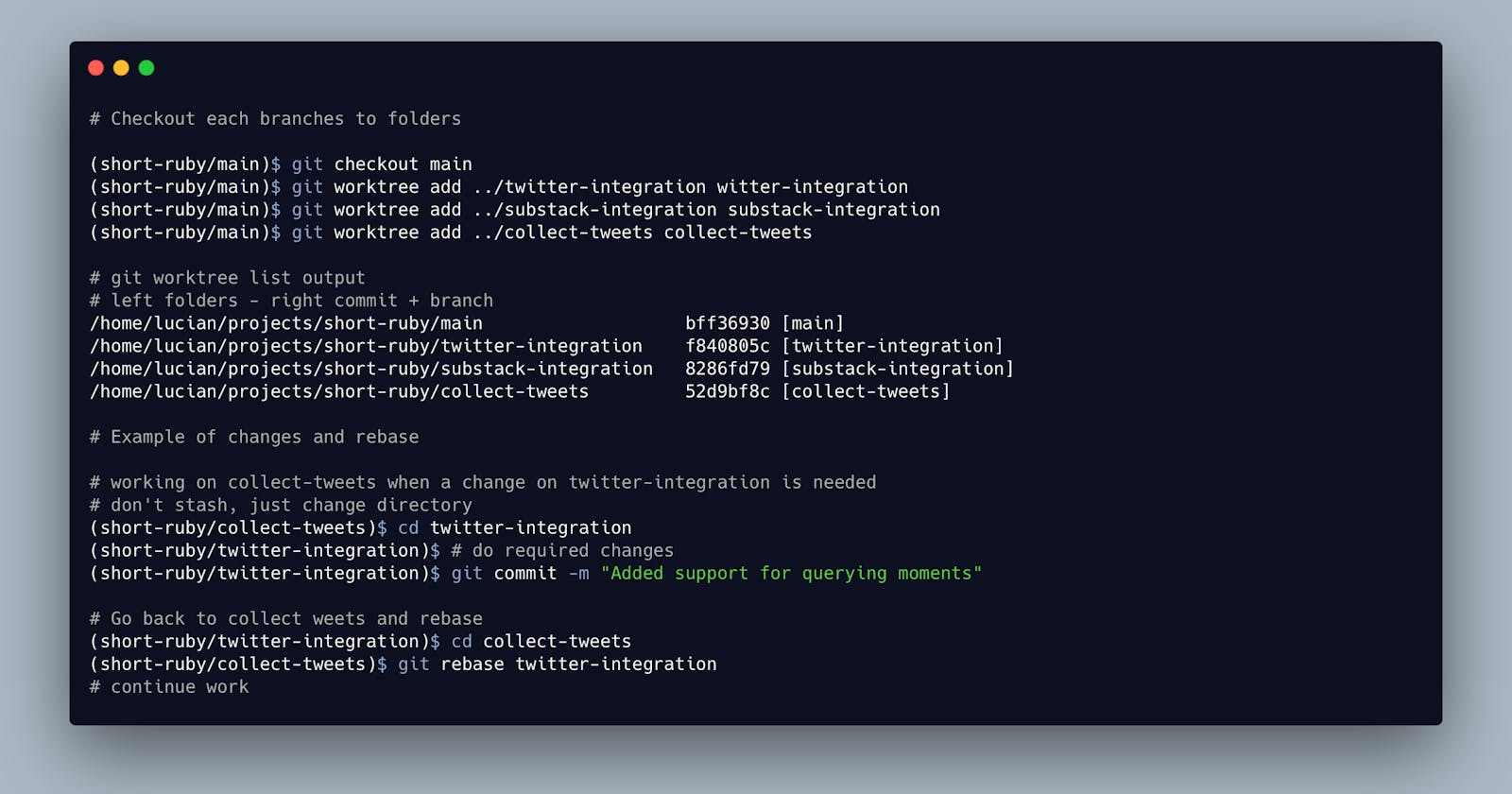Context
Let's say I am working on a project named "short-ruby" 😉
That project is currently located somewhere like
/home/lucian/projects/short-ruby
Let's say that I am currently working on a complex feature named "automate newsletter".
This feature has multiple branches:
twitter-integrationbranched frommainsubstack-integrationbranched frommaincollect-tweetsbranched fromautomate-n/twitter-integration
To test all this stuff, I am also creating a temp merge branch all where I want to test if all work well together before deciding to integrate them to main.
For simplicity
Current task
The first 2 branches are implemented, and I am currently working on collect-tweets.
Now imagine that while working on this branch, I discover that there is something that needs to be changed, and it is related to integration with Twitter, like I need access to also moments, not only lists.
This change should be part of twitter-integration branch.
Git solution without git worktree
What are my options now?
Simple solution
The simplest one is to git stash my current changes from collect-tweets and then git checkout the twitter-integration branch do the changes there, commit them and then come back to collect-tweets and git rebase.
It might look something like this:
# work on collect-tweets
(short-ruby)$ git stash
(short-ruby)$ git checkout twitter-integration
#... do the work
(short-ruby)$ git commit -m "Added support for querying moments"
(short-ruby)$git checkout collect-tweets
(short-ruby)$ git rebase twitter-integration
(short-ruby)$ git stash pop
# resume previous work on collect-tweets
Elegant but more complex solution
Of course, another solution would be to commit the changes in the branch collect-tweets and then git cherry-pick them to the correct branch.
This is an elegant solution, but you have to be careful and remember to make sure your commit was atomic and did not contain anything from the current branch. Of course, you can also fix that with git rebase -i, but still, that is also a solution that works when you always do logical atomic commits.
More changes
Now imagine that you resumed work on "collect-tweets" and then the next day, a bug needs to be fixed on main and the bug means changing a method in a class that was refactored in twitter-integration
You will need again to do a series of stash/checkout/rebase that now will also mean multiple git checkout and rebases as you will want to propagate the changes from main to twitter-integration to collect-tweets.
Probably cannot do cherry picking while you are in twitter-integration or collect-tweets because you refactored that code already so cherry-picking will fail.
Here I think comes in handy git worktree
Git worktree
Git worktree is a simple command that will map a local folder to a branch.
Imagine I said I have the project in /home/lucian/projects/short-ruby
Here is what I can do before going into all branches:
# Rename folder short-ruby to main and create a new folder short-ruby and put main inside
(short-ruby)$ cd ... ; mv short-ruby main ; mkdir short-ruby ; cd short-ruby
(short-ruby)$ mv ../main ./ ; cd main
(short-ruby/main)$ git checkout main
(short-ruby/main)$ git worktree add ../twitter-integration witter-integration
(short-ruby/main)$ git worktree add ../substack-integration substack-integration
(short-ruby/main)$ git worktree add ../collect-tweets collect-tweets
(short-ruby/main)$ git worktree add ../all all
Now if I execute git worktree list it will show an output like this:
/home/lucian/projects/short-ruby/main bff36930 [main]
/home/lucian/projects/short-ruby/twitter-integration f840805c [twitter-integration]
/home/lucian/projects/short-ruby/substack-integration 8286fd79 [substack-integration]
/home/lucian/projects/short-ruby/collect-tweets 52d9bf8c [collect-tweets]
/home/lucian/projects/short-ruby/all 7cc380a4 [all]
What happen is that it created those folders and inside each one it did a checkout with that specific branch.
Now my flow will look like this:
I will cd short-ruby/collect-tweets and work in that folder everything related to the branch collect-tweets.
If I need to do a change on twitter-integration branch:
cd twitter-integration
# do the changes
git commit -m "Added support for querying moments"
cd collect-tweets
git rebase twitter-integration
# continue work
Do I need to do some changes on main?
Simple:
cd main
# do the changes
git commit -m "Bug is fixed"
cd twitter-integration
git rebase main
cd collect-tweets
git rebase twitter-integration
Of course, I can automate rebase on all branches (probably) with something like:
# rebase-automate-newsletter.sh
cd ~/projects/short-ruby/main ; git pull
cd ~/projects/short-ruby/twitter-integration; git pull ; git rebase main
cd ~/projects/short-ruby/substack-integration; git pull ; git rebase main
cd ~/projects/short-ruby/collect-tweets; git pull ; rebase twitter-integration

